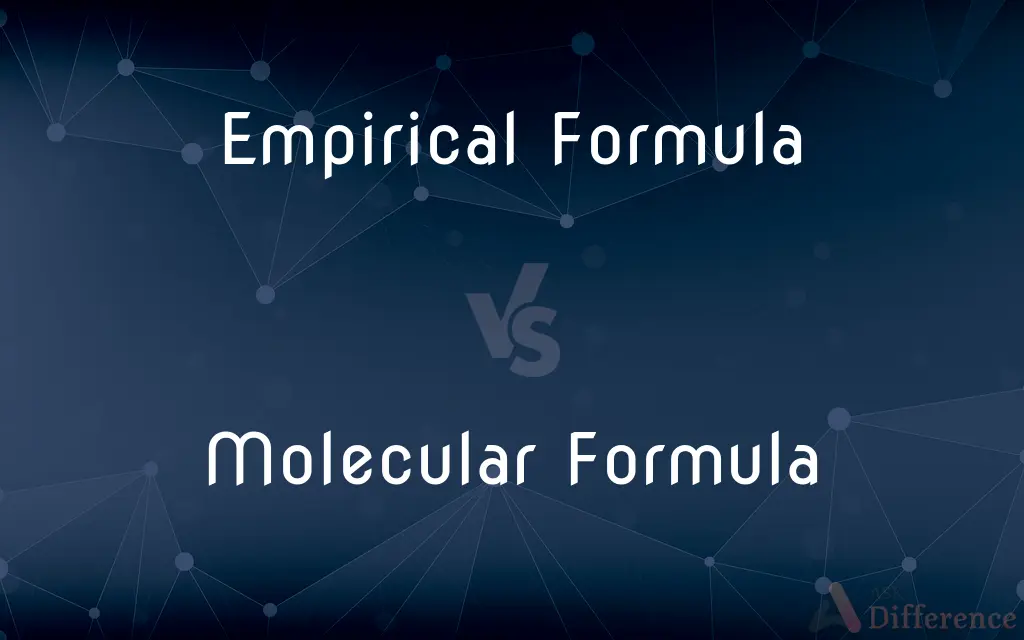Empirical Formula vs. Molecular Formula — What's the Difference?
Edited by Tayyaba Rehman — By Fiza Rafique — Published on December 11, 2023
The Empirical Formula represents the simplest whole-number ratio of elements in a compound, while the Molecular Formula indicates the actual number of atoms of each element present.

Difference Between Empirical Formula and Molecular Formula
Table of Contents
ADVERTISEMENT
Key Differences
The Empirical Formula and Molecular Formula serve distinct purposes in chemistry. While the Empirical Formula provides the simplest ratio of atoms of each element in a compound, the Molecular Formula provides the exact number of those atoms. For instance, in hydrogen peroxide, the Empirical Formula is HO, but its Molecular Formula is H2O2.
Both the Empirical Formula and Molecular Formula are vital for understanding the composition of chemical compounds. The Empirical Formula is often derived from experimental data and gives a generalized idea about the compound's composition. In contrast, the Molecular Formula provides a more detailed and specific insight into the compound's exact atomic composition.
It's possible for different compounds to share the same Empirical Formula while having different Molecular Formulas. This means the Empirical Formula might not provide unique identification for a compound. On the other hand, the Molecular Formula, being specific, can differentiate between these compounds.
When interpreting chemical data, both the Empirical Formula and Molecular Formula offer valuable insights. The Empirical Formula, with its simplest representation, aids in deducing possible compound structures, while the Molecular Formula, by offering atom counts, provides clarity on the compound's molecular weight and structure.
Many times in chemistry, one might start with the Empirical Formula, derived from percentage composition, and then use additional data like molar mass to determine the Molecular Formula. This highlights the interconnectedness of these formulas and their importance in chemical analysis.
ADVERTISEMENT
Comparison Chart
Definition
Simplest whole-number ratio of elements
Actual number of atoms of each element
Information Conveyed
General composition
Specific composition
Example Compound
For glucose: CH2O
For glucose: C6H12O6
Relationship with Molar Mass
Doesn't provide direct info on molar mass
Directly related to the compound's molar mass
Uniqueness for Compound Identification
Might not be unique for each compound
Typically unique for each compound
Compare with Definitions
Empirical Formula
Often a starting point in chemical analysis.
From the Empirical Formula CH2O, several molecular structures can be deduced.
Molecular Formula
Directly related to the compound's molar mass.
Using molar mass, we can deduce the Molecular Formula from the Empirical Formula.
Empirical Formula
Does not indicate the molecule's actual structure.
Both acetic acid and formaldehyde have the Empirical Formula CH2O, but they are distinct compounds.
Molecular Formula
Provides specificity in compound identification.
Ethene has a Molecular Formula of C2H4, distinct from ethane's C2H6.
Empirical Formula
Gives a generalized idea of composition.
The Empirical Formula for ethene and ethane is both CH.
Molecular Formula
Shows the actual number of atoms of each element.
The Molecular Formula for water is H2O.
Empirical Formula
Represents the simplest ratio of elements.
The Empirical Formula for hydrogen peroxide is HO.
Molecular Formula
Can be a multiple of the Empirical Formula.
The Molecular Formula for benzene is C6H6, while its Empirical Formula is CH.
Empirical Formula
Derived from experimental data.
Analysis of a compound gave an Empirical Formula of CH.
Molecular Formula
Gives clarity on the compound's structure.
The Molecular Formula H2O2 clearly indicates the presence of two hydrogen and two oxygen atoms.
Common Curiosities
How does the Molecular Formula differ from the Empirical Formula?
The Molecular Formula indicates the actual number of atoms of each element, whereas the Empirical Formula shows the simplest ratio.
Is the molar mass related to the Molecular Formula?
Yes, the Molecular Formula is directly related to a compound's molar mass.
How is the Empirical Formula typically derived?
It's often derived from experimental data, such as percentage composition of elements.
Why is the Molecular Formula important?
It provides a specific insight into a compound's atomic composition and molecular weight.
Can two compounds have the same Empirical Formula but different Molecular Formulas?
Yes, for example, ethene (C2H4) and ethane (C2H6) both have the Empirical Formula CH.
What does the Empirical Formula represent?
The Empirical Formula represents the simplest whole-number ratio of elements in a compound.
Can the Molecular Formula be deduced from the Empirical Formula?
Yes, with additional data like molar mass, one can deduce the Molecular Formula from the Empirical Formula.
Does the Empirical Formula give information about molecular structure?
No, the Empirical Formula does not indicate the molecule's actual structure.
Share Your Discovery

Previous Comparison
Configurational Isomers vs. Conformational Isomers
Next Comparison
Anaconda vs. King CobraAuthor Spotlight
Written by
Fiza RafiqueFiza Rafique is a skilled content writer at AskDifference.com, where she meticulously refines and enhances written pieces. Drawing from her vast editorial expertise, Fiza ensures clarity, accuracy, and precision in every article. Passionate about language, she continually seeks to elevate the quality of content for readers worldwide.
Edited by
Tayyaba RehmanTayyaba Rehman is a distinguished writer, currently serving as a primary contributor to askdifference.com. As a researcher in semantics and etymology, Tayyaba's passion for the complexity of languages and their distinctions has found a perfect home on the platform. Tayyaba delves into the intricacies of language, distinguishing between commonly confused words and phrases, thereby providing clarity for readers worldwide.
















































